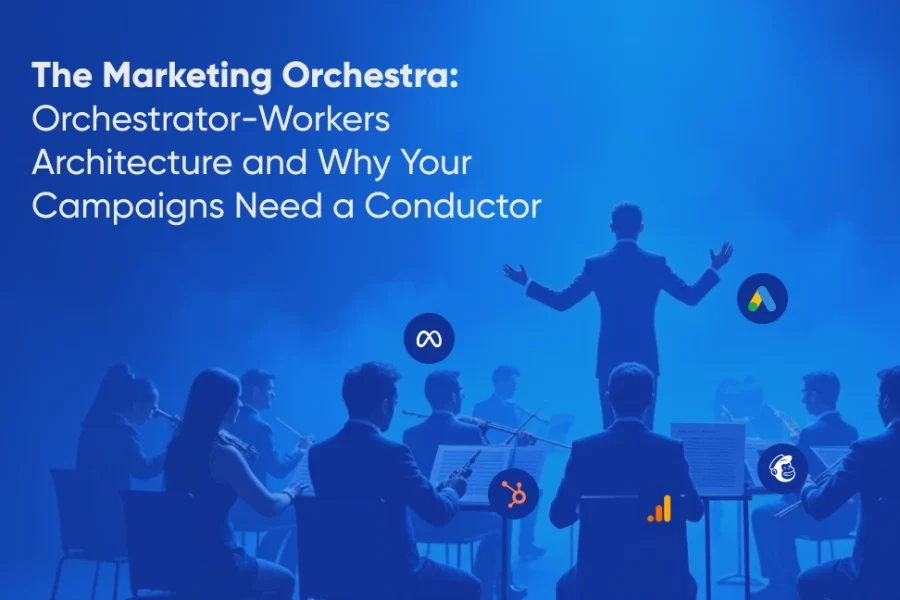Picture this:
You’re 48 hours away from your company’s biggest product launch of the year. Your parallel processing agents are working beautifully creative development, channel optimization, and competitive analysis are all happening simultaneously. But then the CEO walks in with “one small change” to the positioning strategy.
In a parallel processing world, you’d need to manually coordinate updates across five different agents, each working on different aspects of your campaign. By the time you communicate the change to everyone and ensure strategic alignment, you’ve lost precious hours and possibly introduced inconsistencies.
This is where orchestrator-workers architecture becomes your marketing salvation—imagine parallel processing with a brilliant conductor ensuring every agent works in perfect strategic harmony.
The Strategic Alignment Crisis
Let’s acknowledge what’s really happening in marketing organizations today.
According to recent research, only 16% of marketers say their marketing technology strategies are actually aligned with their business strategies. Meanwhile, just 9% of marketers can currently engage customers across channels on a consistent basis.
Here’s the sobering reality:
The difference?
Strategic coordination.
While marketing campaign management software market is projected to grow from $25.17 billion in 2024 to $48.87 billion by 2032, most organizations are still struggling with what happens after they deploy all these tools: strategic orchestration.
What Orchestrator-Workers Architecture Actually Means
Think about the last time you watched a world-class symphony. The violinists, cellists, brass section, and percussion all have different sheet music, different instruments, and different technical requirements. Yet somehow, they create a unified, emotionally powerful experience.
That magic happens because of the conductor someone who understands the full composition, maintains strategic timing, and ensures every section contributes to the overall artistic vision.
Orchestrator-workers architecture brings this same principle to marketing AI. A central orchestrator agent understands your complete business strategy, campaign objectives, and market context. It dynamically breaks down complex marketing initiatives and assigns specialized worker agents to handle specific tasks while maintaining strategic alignment throughout execution.
The result?
Intelligent coordination with strategic oversight parallel execution that never loses sight of the bigger picture.
The “Coordination Chaos” Problem
Here’s what typically happens with complex marketing initiatives involving multiple teams and tools:
- Monday: Strategy team defines campaign direction
- Tuesday: Creative team interprets strategy (with their own creative lens)
- Wednesday: Paid media team builds campaigns (based on their understanding of the brief)
- Thursday: Content team creates assets (hoping everything aligns)
- Friday: Social team develops content (trying to maintain brand consistency)
- Following Monday: Leadership realizes messaging is inconsistent across channels
- Following Tuesday: Emergency meetings to “get everyone on the same page”
- Following Wednesday: Rushed fixes that compromise campaign quality
Sound painfully familiar?
Research shows that 87% of marketers see data as the most underutilized asset in their company, but the real issue isn’t data, it’s strategic coordination of all the moving pieces.
Meanwhile, by integrating marketing teams and channels, organizations see a 31% increase in campaign efficiency and using an integrated approach sees an average of 50% more ROI.
The orchestrator-workers architecture makes this integration seamless and intelligent.
How Orchestrator-Workers Transforms Strategic Execution
Let’s reimagine that complex product launch with orchestrator-workers architecture:
-
Strategic Intelligence Layer
The orchestrator agent continuously monitors business objectives, market conditions, competitive landscape, and brand guidelines. When the CEO introduces that positioning change, the orchestrator immediately understands the strategic implications across all campaign elements.
-
Dynamic Task Delegation
Based on the strategic shift, the orchestrator dynamically reassigns tasks: Worker Agent A updates messaging frameworks, Agent B revises creative concepts, Agent C adjusts media targeting, while Agent D modifies content calendars. All simultaneously, all strategically aligned.
-
Real-Time Strategic Alignment
Unlike parallel processing where agents work independently, worker agents continuously receive strategic guidance from the orchestrator. If Agent B’s creative concepts start drifting from brand guidelines, the orchestrator intervenes immediately, not after the work is complete.
-
Intelligent Resource Allocation
The orchestrator agent monitors campaign performance and worker agent capacity in real-time, dynamically shifting resources to high-priority elements. If competitive intelligence reveals an urgent threat, the orchestrator can reassign agents without disrupting overall campaign flow.
The result?
Strategic changes that used to require days of coordination now happen in hours, with perfect alignment maintained throughout execution.
The Business Case: Why Strategic Leaders Love This Architecture
Let’s talk numbers that resonate with executive teams.
Research shows that CEOs who excel at delegation generate 33% more revenue than those who do not, but traditional delegation lacks the strategic intelligence of orchestrator-workers architecture.
Here’s what makes this architecture compelling for business leaders:
-
Strategic Agility:
Organizations that prioritize marketing strategy documentation have 313% higher success rates, but orchestrator-workers ensures strategy is actively maintained throughout execution, not just documented upfront.
-
Resource Optimization:
Leaders who fail to delegate spend more time on tasks that could be handled by others, detracting from strategic priorities. Orchestrator-workers architecture automates intelligent delegation while maintaining strategic oversight.
-
Coordination Efficiency:
Organizations with aligned marketing and sales processes see 32% higher annual revenue growth, and orchestrator-workers extends this alignment principle across all marketing functions.
-
Crisis Response:
When market conditions change rapidly, 43% of marketers say optimizing productivity is the most important objective. Orchestrator-workers allows instant strategic pivots without coordination delays.
Real-World Applications: Where Orchestrator-Workers Excels
-
Complex Product Launches:
Multi-channel campaigns requiring perfect timing, message consistency, and strategic flexibility. The orchestrator ensures every element serves the overall launch strategy while workers handle specialized execution.
-
Market Entry Campaigns:
When entering new markets with different regulatory requirements, cultural sensitivities, and competitive landscapes. The orchestrator maintains strategic coherence while workers adapt to local conditions.
-
Crisis Management:
During PR challenges or competitive threats, the orchestrator rapidly deploys appropriate responses across channels while ensuring message consistency and strategic alignment.
-
Seasonal Mega-Campaigns:
Holiday seasons or industry events where timing is everything and strategic coordination can make or break performance. The orchestrator manages complex timelines while workers execute specialized tasks.
-
Enterprise Rebrand Initiatives:
When changing brand positioning, messaging, or visual identity across dozens of channels and hundreds of assets. Perfect coordination is essential for brand integrity.
When Orchestrator-Workers Isn’t the Right Choice
-
Strategic transparency:
orchestrator-workers architecture isn’t always optimal.
-
Simple, Single-Objective Campaigns:
If you’re just running basic email campaigns or simple social media promotions, the orchestration overhead isn’t justified.
-
Highly Creative, Experimental Work:
When campaigns depend on creative exploration and artistic iteration, human creativity should lead rather than strategic automation.
-
Small, Resource-Constrained Teams:
Organizations with fewer than 5 marketing team members might benefit more from prompt chaining or parallel processing before scaling to orchestration.
-
Well-Established, Repetitive Processes:
If your marketing workflows are already highly standardized and rarely require strategic adjustments, simpler architectures may be more efficient.
Getting Started: Your First Orchestrated Campaign
Ready to test orchestrator-workers architecture?
Start with a medium-complexity, multi-channel initiative:
-
Define Strategic Parameters:
Clear campaign objectives, brand guidelines, target audiences, and success metrics that the orchestrator agent will maintain
-
Map Worker Specializations:
Identify distinct marketing functions (creative, media, content, analytics) that can operate as specialized worker agents
-
Establish Coordination Protocols:
Define how often worker agents should check in with the orchestrator for strategic guidance
-
Choose Your Pilot Campaign:
Select a campaign with moderate complexity where mistakes aren’t catastrophic
-
Monitor Strategic Consistency:
Track how well the orchestrator maintains alignment across all worker outputs
The Leadership Reality You Can’t Ignore
Here’s what’s happening in the C-suite while you’re reading this:
71% of employees do not trust their leaders’ capability to take their organization to the next level, largely because leaders struggle with strategic coordination at scale.
The companies mastering orchestrator-workers architecture aren’t just executing campaigns faster, they’re demonstrating strategic leadership that builds confidence across the organization. When marketing initiatives maintain perfect strategic alignment despite complexity and rapid changes, it signals sophisticated operational capability to investors, partners, and top talent.
While your competitors struggle with coordination chaos and strategic drift, orchestrator-workers architecture positions your marketing team as a strategic asset that scales with business complexity.
The Strategic Evolution Path
We’ve now covered sequential precision (prompt chaining), concurrent execution (parallel processing), and strategic coordination (orchestrator-workers). But what happens when you want your marketing AI to learn and improve autonomously?
Next Blog: We’ll explore autonomous agents architecture imagine orchestrator-workers that continuously learns from performance data, market changes, and customer behavior to optimize strategies without human intervention. Think of it as having a brilliant marketing strategist who never sleeps, never forgets lessons learned, and constantly improves campaign performance.
Because while orchestrator-workers architecture solves the coordination problem, autonomous agents solve the continuous optimization problem. And in today’s fast-moving markets, you need both strategic coordination and intelligent adaptation.
Keep updated to discover how the most advanced marketing organizations are building AI architectures that provide strategic advantage, not just operational efficiency. Your competitive differentiation increasingly depends on how intelligently you orchestrate complexity.
Ready to implement orchestrator-workers architecture in your marketing operations?
Explore our Agentic AI services or calculate your potential strategic alignment improvements with our ROI calculator.
Building on the foundation?
Read “The Marketing Dream Team: How Parallel Processing Turns Your AI into a Multi-Tasking Superhero” to understand concurrent AI execution.


